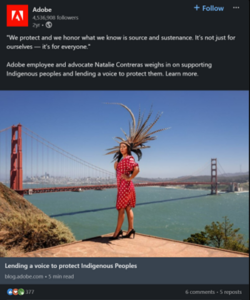- Build Credibility & Influence
- Develop a Communications Strategy
- Increase Brand Awareness
- Tackle Tough Issues
- Taking Aim
Strategic Engagement: Navigating the Social Media Landscape with Authenticity and Inclusion

April 8, 2024
By Sarah Kelliher
Learn how to align your online presence with internal culture, including social media best practices for holidays and awareness days.
Social media has created an online community where every interaction is a chance to advance your narrative. For marketing professionals, managing brand identity on these platforms is not just a matter of communications strategy, but a strategic business imperative.
Especially as more organizations prioritize social responsibility, the challenge lies in engaging authentically. How can you join broader conversations without offending stakeholders, compromising the integrity of your brand, or negatively impacting business goals?
The timing and tone of your social media content should be carefully crafted to ensure it not only educates and entertains your online community, but also drives business objectives.
By managing social media for clients in diverse industries and advising corporate social responsibility initiatives, we have learned some important lessons about navigating today’s dynamic social media landscape with authenticity and inclusion.
External Dialogue Should Reflect Internal Culture
To post or not to post?
When deciding whether to address culturally sensitive moments, recognize key dates, or articulate a stance on pivotal issues, our rule of thumb is straightforward: your online presence should represent your offline culture.
This principle is particularly relevant when it comes to key awareness dates and holidays. If you are not acknowledging these occasions internally through the values, practices and principles that define your organization’s unique culture, do not acknowledge them externally on social media.
Unless you are planning internal communications and special events, creating policies, or otherwise acknowledging a religious holiday, awareness date or similar event, anything you post about these occasions on social media will be insincere.
This becomes even more challenging when an organization is striving to be inclusive, but it hasn’t yet fully adopted those values or is engrained in its culture. This is why knowing when to speak versus when to amplify is critically important.
Be the Microphone; Not the Voice
When it comes to culturally sensitive topics, it may benefit you to pass the microphone. If you deem a particular topic authentic to your brand, consider sharing content from other organizations or individuals with subject-matter expertise or relevant lived experiences.
This can look like an employee spotlight, featuring the perspective of a team member who can speak about their experience as an observer of the cultural awareness date or holiday in question. However, it’s important to ensure that you are telling your employees’ stories authentically, versus taking advantage of their experiences and using them as opportunities to tout your company’s commitment to inclusivity.
Adobe’s Life Team does a great job of this. One noteworthy example is its piece for International Day of the World’s Indigenous Peoples (August 9), for which an Adobe employee shared their perspective as a member of the Indigenous community. Their powerful story not only raised awareness about important issues but also showcased Adobe’s commitment to amplifying the voices of Indigenous people worldwide. The blog was then shared on several of Adobe’s social media accounts, which have millions of followers.
Although you’ll want to take care with providing an endorsement for external organizations or individuals, some events may also present opportunities to amplify the voices of subject-matter experts, including your community partners or other external stakeholders with a credible point of view. Sharing their content supports relationship-building efforts while providing a platform for credible and authoritative perspectives. This can lead to opportunities for collaboration, mutual support and knowledge sharing — all important elements of success for an inclusive culture.
Read the Room: Strike the Right Tone
Social media may seem like fun and games, but it’s serious business. Even if your brand voice is lighthearted and humorous, be sure your content maintains a respectful tone, especially when discussing observances or holidays that hold deep significance for many people.
Jokes can damage your reputation and relationships, and be perceived as insensitive, unprofessional or out of touch. Although you can “delete” posts, it is nearly impossible to fully erase the impact of your words online, even after they’ve been removed from your profile.
One example that comes to mind is Burger King UK. The company faced intense backlash after tweeting “Women belong in the kitchen” on International Women’s Day in 2021 to grab people’s attention about its X/Twitter thread about the lack of female chefs in the restaurant business. While they intended to shine a light on a relevant issue, the execution was poor and the effort completely backfired. Most followers were so incensed that they stopped reading beyond the initial text and failed to read supporting posts to get the point (could you blame them?!).

Reading the room isn’t just about posting tone-appropriate content, but also about knowing when to refrain from posting altogether. When in doubt, check your social media feeds, trending hashtags and breaking news to ensure you aren’t posting the right content at the wrong time. No matter how good it is, your content will fall flat if it’s shared when your online community is paying attention to other things, such as breaking news with significant impact or religious holidays.
Be Prepared to Respond
Regardless of what your company chooses to share or not share on social media, having an online presence opens the door for audience feedback, both positive and negative.
You should always be prepared with a brief holding statement or key messages to respond to stakeholders who ask why or why not something was posted. While you may initially be met with heightened emotions, embracing this dialogue can be a powerful way to build trust, foster engagement and gain valuable insights from your audience.
The next time your organization is wrestling with what to or what not to post on social media, remember that it’s so much more than just checking a task off your to-do list and hitting “publish” on a post.
Anyone can add to the online noise, but how will your company leverage social media to make a meaningful impact and grow your business? The ball is in your court.





